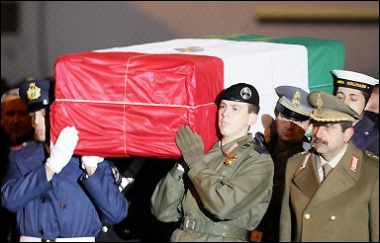|
Italy: Agent's shooting not deliberate
(Agencies)
Updated: 2005-05-03 08:38
Italian investigators blamed U.S. military authorities for failing to signal
there was a checkpoint ahead on the Baghdad road where American soldiers killed
an Italian agent, and concluded in a report released Monday that stress,
inexperience and fatigue played a role in the shooting.
The investigators found no evidence, however, that the March 4 killing of
intelligence agent Nicola Calipari was deliberate. The Italians also didn't
object to many of the findings of fact contained in a separate American report
made public Saturday.
Still, they refused to sign off on the U.S. conclusion that the soldiers bore
no blame for Calipari's death. For example, while the American investigators
said the car was traveling more than 50 mph, the Italians said it was going half
that speed.

Nicola Calipari's coffin arrives at Ciampino
airport in Rome. The government blamed the killing of the senior Italian
intelligence agent in Baghdad on the 'inexperience' of US troops acting
under stress and without proper rules of engagement.
[AFP/file] | The two sides issued separate reports
after a joint investigation.
Premier Silvio Berlusconi, a staunch American ally, has faced political
fallout in Italy over the rift, including calls to bring home the country's
3,000 troops from Iraq. Berlusconi is scheduled to address both houses of
parliament on the case Thursday.
Calipari was killed just after he secured the release of Italian journalist
Giuliana Sgrena from Iraqi militants who held her hostage for a month. U.S.
soldiers fired on the Italians' vehicle as it approached the checkpoint on a
particularly dangerous road near Baghdad's airport. Sgrena and another Italian
agent were wounded.

Italian intelligence officer Nicola Calipari,
who died in a hail of bullets at a U.S. checkpoint on March 4 as he was
driving to Baghdad airport with Italian journalist Giuliana Sgrena after
winning her release from kidnappers, speaks on a mobile phone in this
undated file photograph.[Reuters] | "It is likely that the state of tension stemming from the conditions of time,
circumstances and place, as well as possibly some degree of inexperience and
stress might have led some soldiers to instinctive and little-controlled
reactions," said Italy's 52-page report.
The U.S. investigators, in their report, said the American soldiers gave
adequate warning, beaming a light and firing warning shots, as the car traveled
toward the airport. Their absolving the U.S. soldiers of any wrongdoing sparked
outrage in Italy, where Calipari had been hailed as a hero.
The Italian report stressed that the American soldiers failed to provide
warning there was a roadblock ahead. There were no signs, bright cones,
concertina wire or anything else to inform drivers they were approaching a
checkpoint, it said.
The American report downplayed the issue of warning signs before the
roadblock.
The Italian report, written by a diplomat and a general assigned to Italy's
secret services, said no measures were taken by U.S. officials to preserve the
scene of the shooting. It said the car carrying Sgrena and the agents was
removed before its position was marked, for example. The soldiers' vehicles also
were moved.
"That made it impossible to technically reconstruct the event, to determine
the exact position of the vehicles and measure the distances, and to obtain
precise data defining the precise trajectory of the bullets, the speed of the
car and the stopping distance," the report said.
From the first hours after the shooting, the two sides had disagreed on
whether there was adequate warning before the shooting and on the speed of the
vehicle. The Americans insisted the Toyota Corolla was going fast enough to
alarm the soldiers, but the Italians said the car was not speeding. Both sides
based their estimates on circumstantial information.
Italy and the United States have publicly differed over other crucial points,
including whether or not the Italians had told U.S. officials why they were in
Iraq. When several days of negotiations failed to yield a common report, both
sides went their own way.
Both reports agreed that about 20 minutes before the shooting, an Italian
officer who was the coalition forces' second-in-command in Iraq confirmed to his
American aide that the flurry of activity along the airport road had something
to do with the Italian journalist.
The Italian then told the American that it was best that no one should know.
The American interpreted that statement as an order not to divulge that
information.
The U.S. report contained many blacked-out portions, including the names of
the soldiers at the checkpoint and their units. But because of an apparent
error, what was blacked out in the report could be read on the Web site of the
Italian newspaper La Repubblica.
Some of the material that had been blacked out also discussed training for
checkpoint duty and checkpoint procedures.
The U.S. military said it regretted the faulty posting.
"We need to improve our procedures. We regret this happened. We obviously
didn't take sufficient precautions," said U.S. Air Force Col. Donald Alston, a
spokesman for U.S.-led forces in Baghdad. He added that some of the leaked
information appeared classified.
The Italian report does not name the American soldiers, identifying them by
codes.
Their report noted that the Americans gave several reasons for the lack of
warning signs before the roadblock. Among them was that the signs belonging to
that U.S. unit were in the hands of "technicians" charged with covering with
tape material deemed offensive to civilians.
For a sign that read "Stay back 100 meters or you will be shot," they were to
cover up with tape "or you will be shot," according to the American report.
According to U.S. officials, the Army National Guard soldiers in charge of
the traffic-blocking position near Baghdad airport had been reassigned to patrol
the airport road just two weeks before the shooting.
Their unit previously had operated in Taji, about 20 miles north of Baghdad,
where their main mission was to conduct patrols in search of insurgents who had
launched attacks on U.S. military bases.
The U.S. report on the incident said the soldiers had received training on
what the military calls "rules of engagement," defining how they respond to
threats, as part of their deployment preparation at Fort Hood, Texas, and the
National Training Center in California.
They were further trained upon arrival in Kuwait last fall, and in February
they received refresher training on the rules of engagement, including a
briefing on positive identification, which requires soldiers to have "reasonable
certainty" that an object they attack is a legitimate military target.
The U.S. report makes clear that the soldiers were operating a
traffic-blocking, rather than traffic-controlling, point. The difference is that
the object of blocking traffic is to ensure that no vehicle proceed past a given
point — in this case the onramp to the road leading to Baghdad airport.
Although they had training and experience in operating traffic control
points, where cars are stopped and searched, the U.S. investigators said they
found no evidence that the soldiers were trained to run blocking positions
before their arrival in Iraq. The soldiers "learned and practiced" how to run
blocking positions from Feb. 5-15, after relocating from Taji.
The Italian report said investigators found there was lots of confusion among
officers and soldiers regarding the rules and procedures governing blocking
positions.
| |
 |
|
 |
|
|
Today's
Top News |
|
|
|
Top World
News |
 |
|
 |
|
|
|
|
|
|


